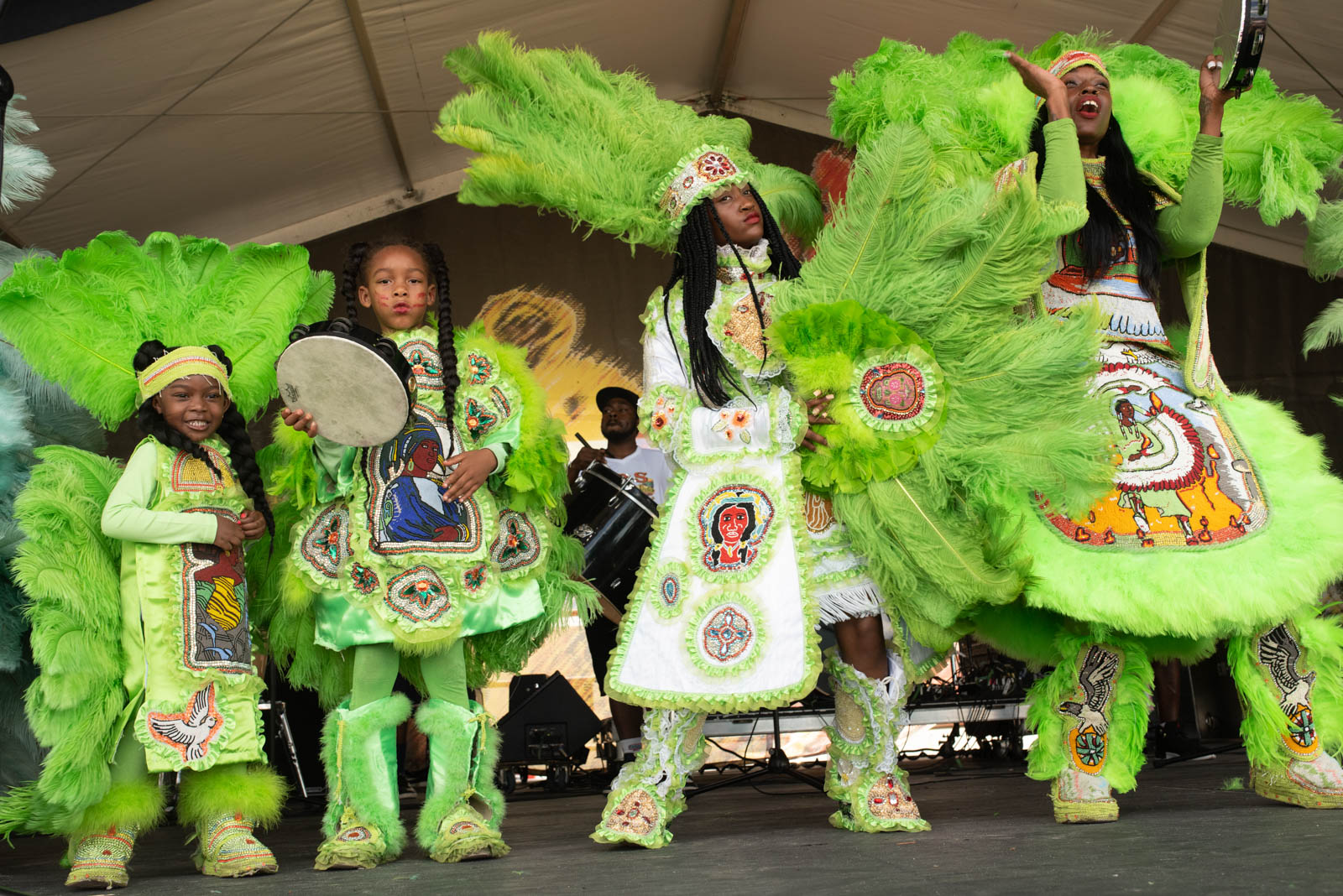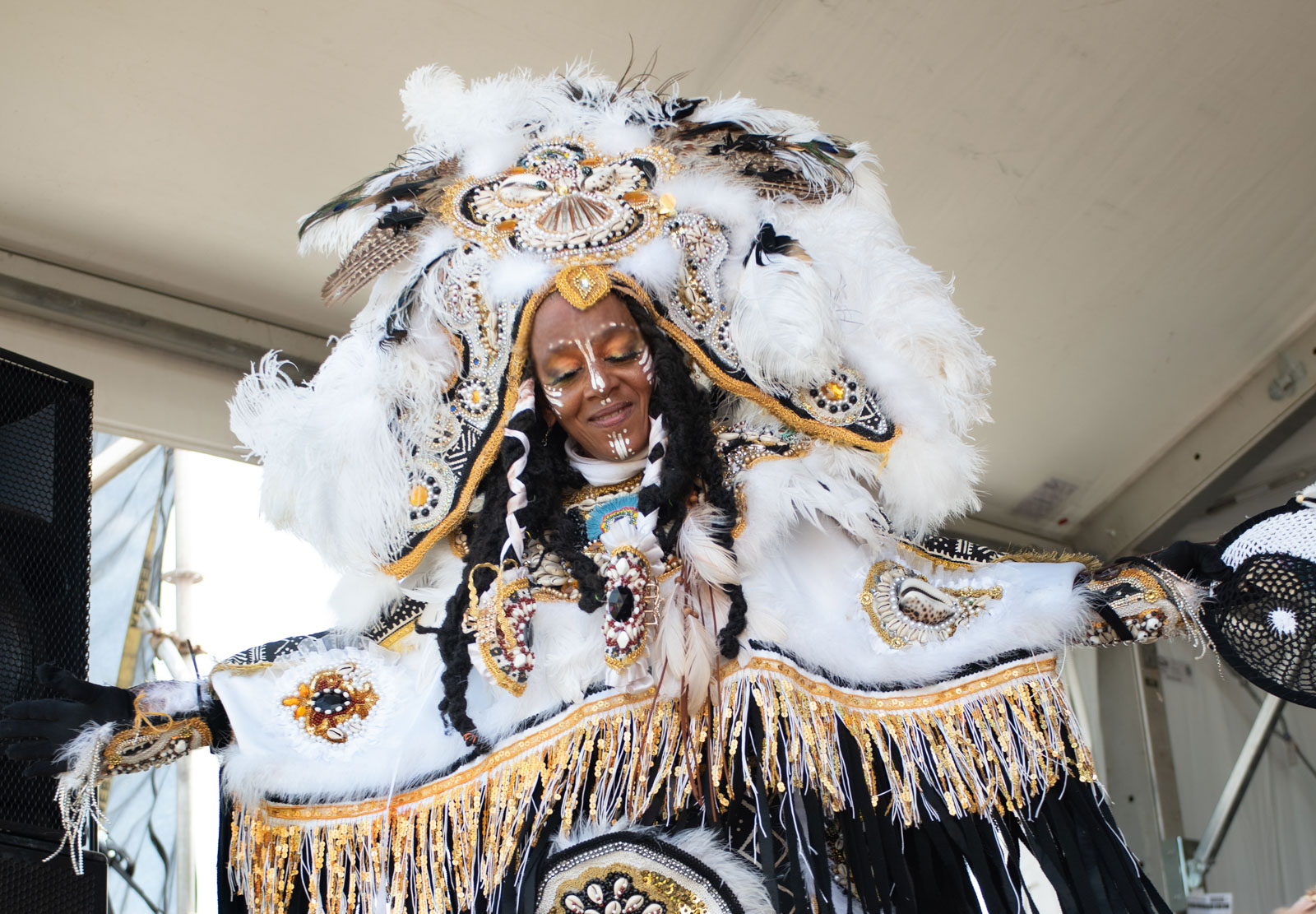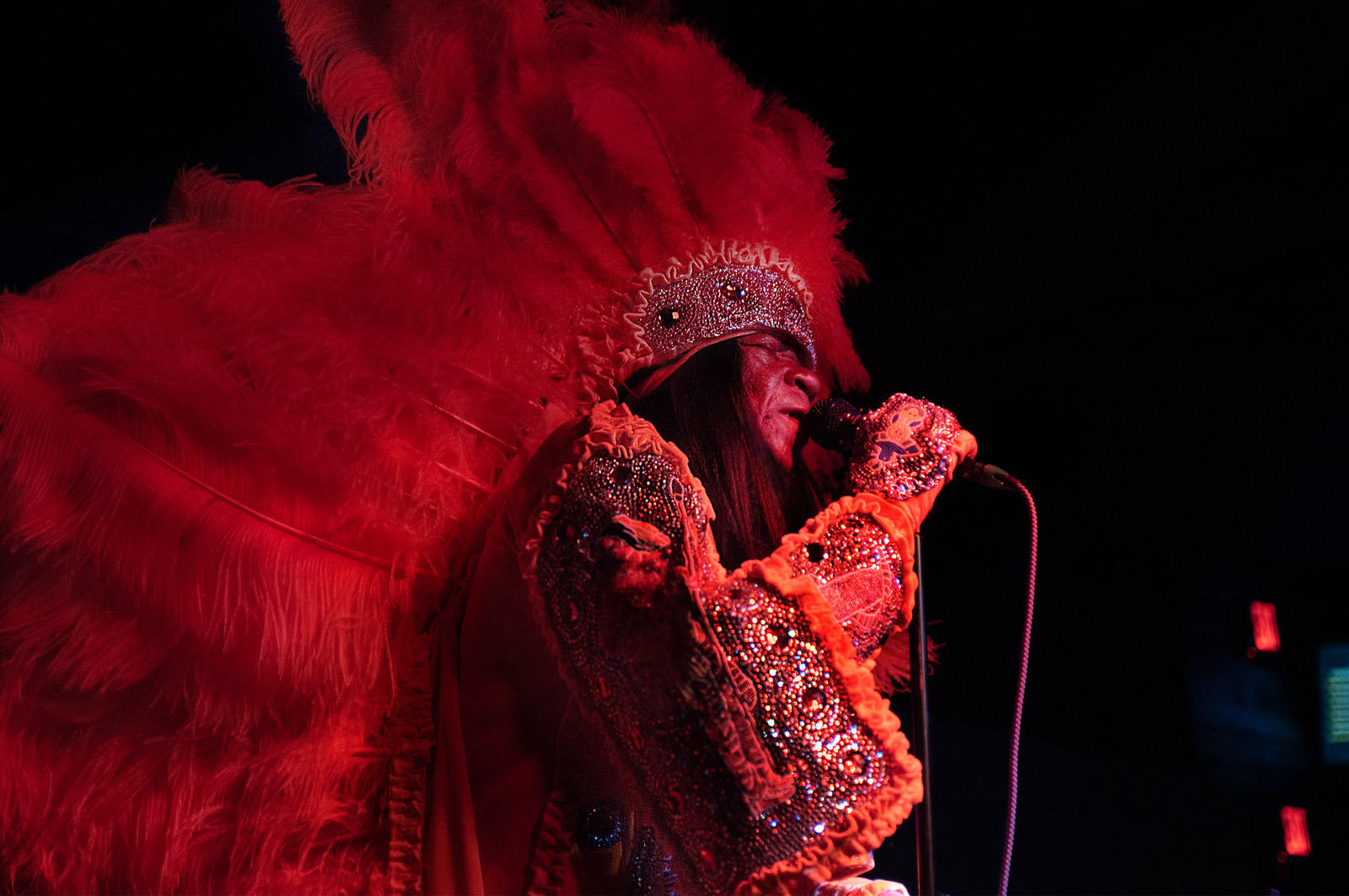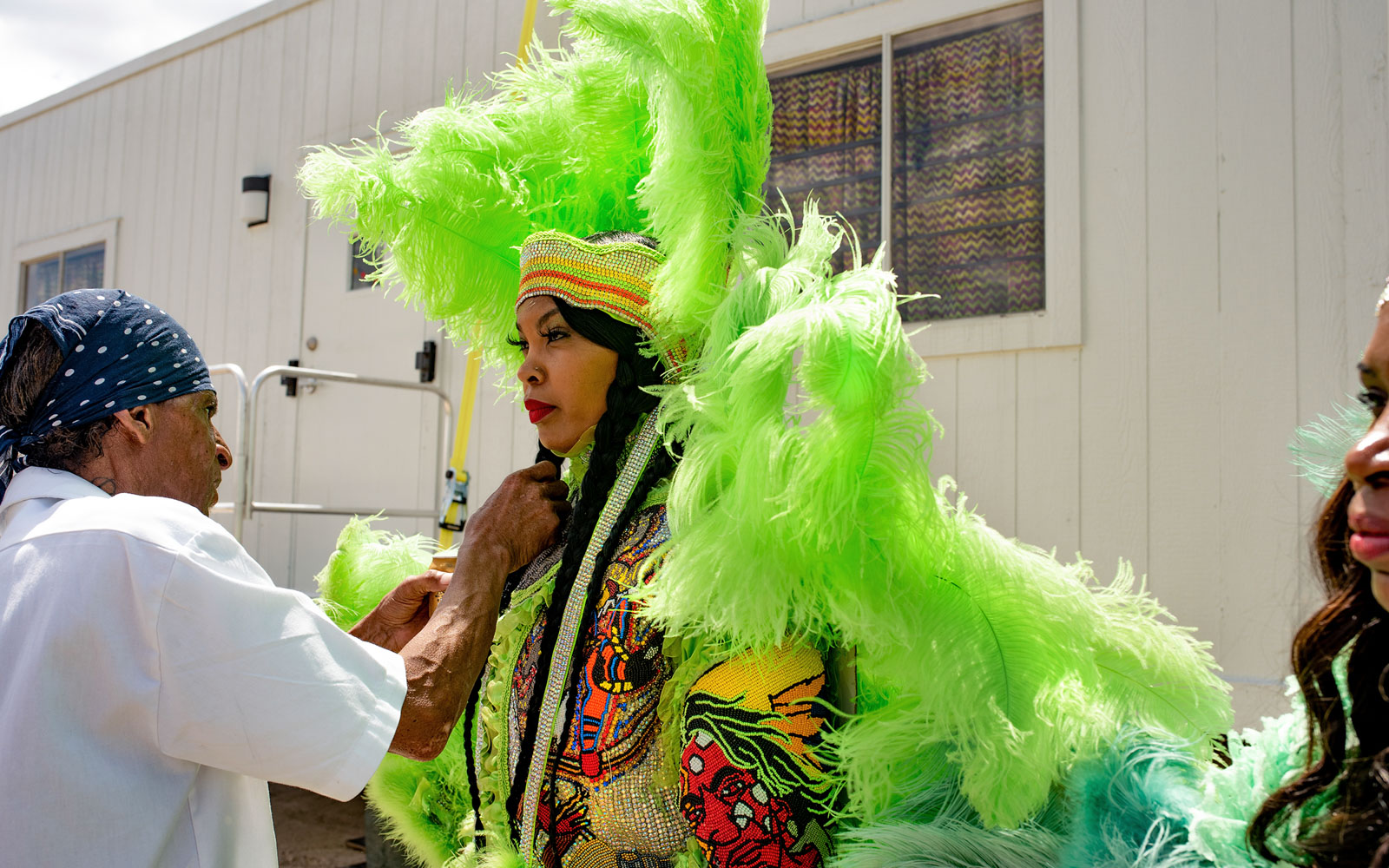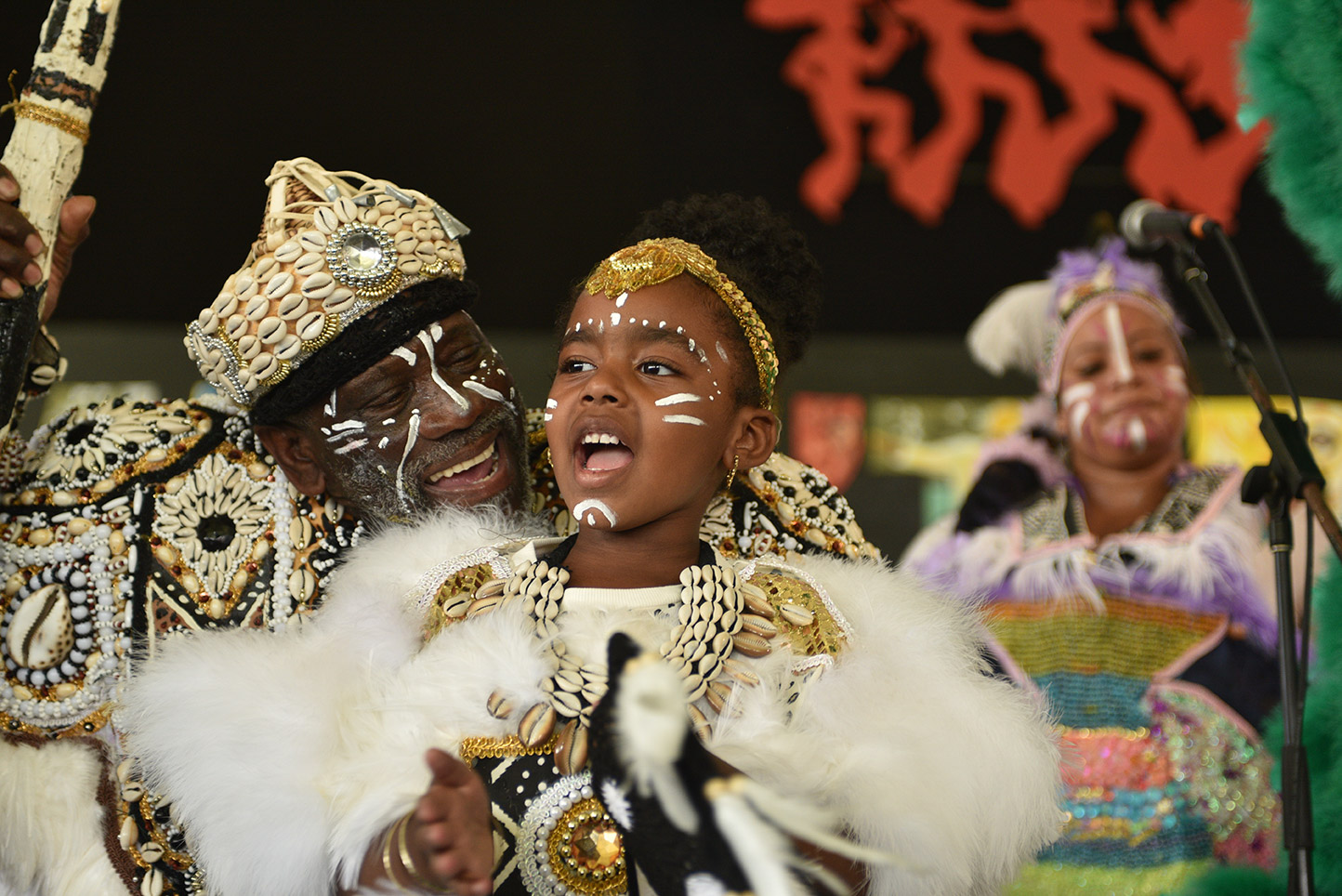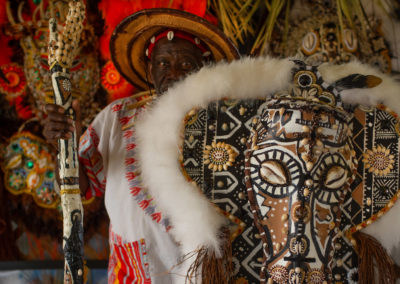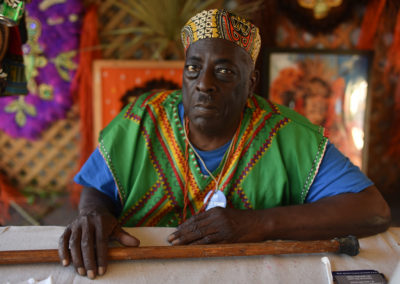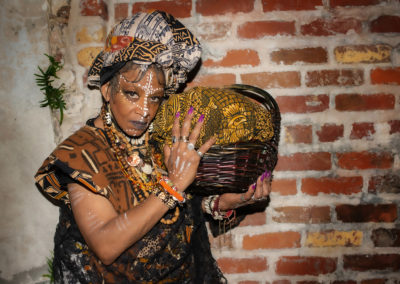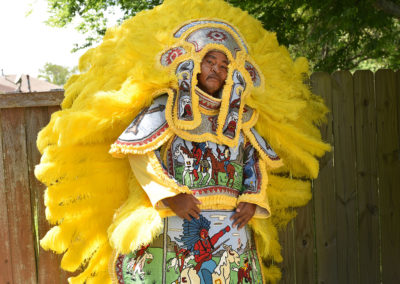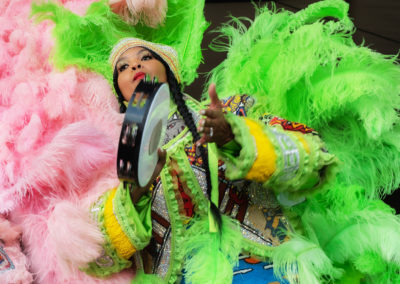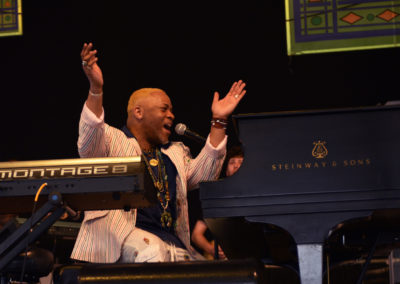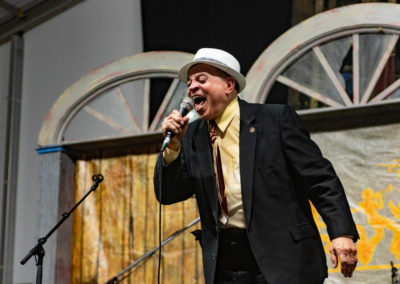As recently as the early 1980s, only a handful of tribes appeared at the New Orleans Jazz and Heritage Festival. In 2022, more than 40 performed on stage and paraded through the Fair Grounds, giving attendees from around the world a taste of one of the city’s most enduring and enigmatic cultural traditions.
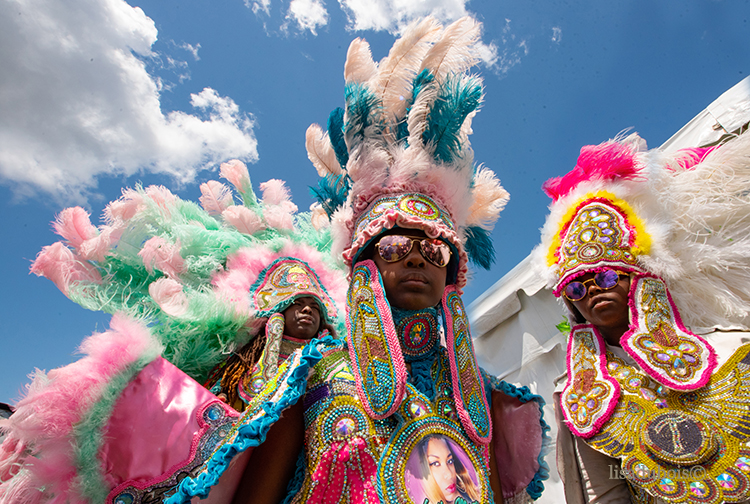
A member of the Black Hawk Hunters in a suit honoring his mom at the 2022 Jazz Fest
The iconic tribes, with roots in the intermingling of Native and African cultures, have had a presence at the festival since its debut in 1970.
Masking and festing:
colorful tribes represent NOLA heritage
By Graham Button and Lisa DuBois
Over the last weekend of April and the first weekend of May, the New Orleans Jazz and Heritage Festival made a triumphant return to the Fair Grounds after a two-year hiatus because of Covid. A motherlode of music and food, art and culture, Jazz Fest, as it’s more commonly known, has come to epitomize much of what people love about New Orleans and Southeast Louisiana. A multitude of local, national and international bands and performers, in a wide range of genres, appeared along with an eclectic mix of local cultural groups representing the “heritage” in the event’s official name.
Mardi Gras Indians have been a part of Jazz Fest since its debut in 1970. Back then, the flamboyant tribes, with roots in the intermingling of Native and African cultures during colonial times, were strictly a backstreet phenomenon whose traditions and music were mostly unknown to the general public. A Jules L. Cahn video of the first Jazz Fest shows a perplexed Woody Allen, the filmmaker and jazz enthusiast, observing a group of Indians coming from the French Quarter, a place where they’d normally never set foot when masked. They’d been trolling for tourists to bring back to the festival, which took place in Congo Square and was sparsely attended.
Creole Wild West Queens at Jazz Fest 2022
The tribe prides itself on bringing women and children into a tradition historically rooted in a macho “warrior” culture.
Today, Jazz Fest is a juggernaut — total attendance in 2022 was 475,000, according to the producers — and the tribes and their Chiefs are celebrated icons, who can legitimately be said to represent the multicultural soul of New Orleans.
Just as the 2006 Jazz Fest helped revive the city and its all-important cultural economy after Hurricane Katrina, the 2022 edition provided a much-needed boost in the wake of the pandemic, which tested the resilience of local culture bearers who present their traditions in public settings. More than 40 Mardi Gras Indian tribes performed on stage and paraded through the Fair Grounds, giving attendees from around the world a taste of one of the city’s most enduring and enigmatic cultural traditions.
(Note on terminology: Although “Mardi Gas Indian” is a commonly used term, it originated from outside the culture. Historically, those who “mask Indian” have self-identified as “Indian.” In recent years, the terms “Black Masking Indian” or “Black Indians of New Orleans” have gained currency.)
A co-mingling of cultures
In colonial Louisiana, Natives and people of African descent shared an experience of subjugation and displacement, traded goods with each other and intermarried. Their kinship also was rooted in their animist belief systems and the respect and sanctuary that Native tribes offered to people of color.
In the 1800s, people with African ancestry found themselves increasingly marginalized — and thus, excluded from mainstream Mardi Gras festivities. Identifying with the proud defiance of Native people to encroachments on dignity and tribal lands, they took to the streets, in the guise of fierce Indian warriors, to express ritual freedom, channel African modes of expression, and honor Natives for having aided self-emancipated fugitives.
In part because of the distinctive use of brightly colored plumes mixed with traditional Native forms of attire, Black Indian masking has at times been misunderstood as disrespectful appropriation and mimicry rather than in terms of a shared heritage. In the facial features of many New Orleanians, including some prominent members of the Indian masking community, the comingling of African and Native bloodlines is readily apparent.
Voodoo priestess and Fi Yi Yi Big Queen Resa “Cinnamon Black” Bazile at the 2022 festival
Highly skilled with the needle and thread, she is a prominent figure in the New Orleans cultural community.
Big Chiefs and the members of their tribes — typically with help from family members and behind-the-scenes operatives who don’t mask but support the culture — spend countless hours creating their regalia. The designs on the “suits” often tell stories and provide history lessons that reflect profound respect for Native people and their bravery in struggles against would-be conquerors. Coming out with a new suit year after year, without taking a break, is key to becoming highly respected within the culture.
As recently as the early 1980s, only a handful of tribes appeared at Jazz Fest. But as the scale of the event grew, so did the presence of the Indians and another vital component of local culture — Social Aid and Pleasure Clubs, known for their Sunday street parades in which fancily attired members in coordinated colors strut and dance to the sounds of brass bands. In 2005, the festival introduced a new stage, the Jazz and Heritage Stage, to highlight local brass bands and Mardi Gras Indians.
The festival offers an opportunity to see the Indians in a mode akin to how they operate when appearing on neighborhood streets on Mardi Gras, St. Joseph’s Night (March 19) or one of the so-called Super Sunday events in March and April, preceding Jazz Fest. Although those who are masked draw most of the attention, the accompanying “second line” stokes excitement. It’s comprised of tribe members and supporters in street clothes, some with percussion instruments, who partake in, and sometimes even lead, the call-and-response chants that are a signature of Mardi Gras Indian music.
A beloved culture bearer
Traditionally, that music was strictly acoustic — singing and chanting accompanied by hand percussion, primarily tambourines. A transformation began in 1970 when Joseph Pierre “Monk” Boudreaux of the Golden Eagles joined with Theodore Emile “Bo” Dollis of the Wild Magnolias to make a studio recording of “Handa Wanda.” They were backed by keyboardist Willie Tee, drummer Joseph “Zigaboo” Modeliste and bassist George French.
Monk Boudreaux performing during Jazz Fest at the Blue Nile club
He has played a pivotal role in bringing Mardi Gras Indian music to a global audience.
Further collaborations with Willie Tee resulted in a groundbreaking synthesis of Mardi Gras Indian music with funk and R&B arrangements and instrumentation. As co-lead singer, alongside Big Chief Bo, of the performance (as opposed to street masking) iteration of the Wild Magnolias, and in appearances with June Victory’s Bayou Renegades band, Monk became a force in bringing the music of the Indians to a global audience. Still going strong at age 80, he is the oldest Mardi Gras Indian Big Chief and one of the most beloved New Orleans culture bearers.
He counts both Choctaw and Cherokee among his ancestors. His daddy masked with the Wild Squatoolas tribe back when Mardi Gras Indian affiliations were kept secret — a legacy of people with Native heritage living in fear of being uprooted and sent to a reservation.
Monk, who grew up admiring blues singers and performed at the first Jazz Fest, became a prolific and versatile vocalist. This year at Jazz Fest, he appeared with his Golden Eagles tribe; Voice of the Wetlands All Stars, a group formed to record and perform songs aimed at raising awareness of threats to a resource essential to the region’s viability; and the Boudreaux Family of Fathers, a multigenerational ensemble that included his son Joseph Boudreaux Jr. and grandson J’wan Boudreaux.
In 2021, Monk received a Grammy nomination, in the Best Regional Roots Album category, for his Reggae-inflected Bloodstains & Teardrops, recorded in part in Kingston, Jamaica. Also nominated in the same category was Cha Wa for its album My People, which featured both J’wan Boudreaux and his uncle Joseph Boudreaux, Jr. on vocals.
Late last year, Joseph and some of his bandmates left Cha Wa to form The Rumble. At Jazz Fest this year, both groups offered a contemporary take on Mardi Gras Indian music — leaning into modern New Orleans funk with lineups incorporating electric instruments and horns.
Keeping it real with the Creole Wild West
Lil Walter adjusting Creole Wild West Queen Melissa “Missy” Bean-Tanner’s suit
Elders want to be remembered for not just their own artistry but also instilling in younger generations the patience and dedication necessary to ensure the tradition’s continuity.
The Creole Wild West, generally regarded as the oldest tribe in the city, is, by contrast, traditional in its approach, utilizing only hand percussion along with drums and congas when performing on stage. Their rhythms are raw, unadorned and soulful.
In 1976, at age 16, Walter Cook, Jr., representing the third generation of his family to mask, became the tribe’s Chief. His daddy, Walter Cook, Sr. (Big Walter), co-founded the Wild Magnolias tribe around 1959. His maternal grandmother was a full-blooded Choctaw. His paternal grandfather masked with the Wild Squatoolas in the 1920s.
Impressively, Lil Walter masked for 51 straight years before taking a break in 2014. Although his last time masking was Mardi Gras 2019, he continues to lend a helping hand to many in the Indian masking community and takes pride in having brought numerous women and children into the tradition.
Assuming a supporting role, as Big Chief Terrance Mitchell took the lead, Lil Walter didn’t suit up for the Creole Wild West’s performance at Jazz Fest. Nevertheless, he was aglow as the Jazz and Heritage Stage nearly overflowed with children, most of them masked. A short time later, a group of the tribe’s Queens, supported by male vocalists and percussionists in street attire, lit up the Cultural Exchange Pavilion. Big Chief Terrance sang praises, with the Queens and the crowd responding to each his lines by chanting “Creole Wild West”:
Queens of the Nation
Young generation
What they holler about
Boy they pretty
Best in the city
African affinity
Big Chief Victor Harris and his granddaughter
His Queens dress in a way that complements his suits, the color of which changes from year to year.
For 20 years, Victor Harris masked in the Yellow Pocahontas under legendary Big Chief Allison “Tootie” Montana. He reinvented himself in 1984, when a spirit (Fi Yi Yi) came into his life as a force of healing and protection — and a conduit for achieving communion with African ancestors.
His new identity and look marked a radical departure from Native antecedents that had long informed the New Orleans Indian masking tradition. Instead of open-face crowns, the Big Chief of Spirit of Fi Yi Yi and the Mandingo Warriors took to wearing African-style masks that covered his face. Intricate, abstract beading and stonework embellished with cowrie shells also became a hallmark of his designs, produced in collaboration with Mandingo Warriors drummer Jack Robinson.
When masked, Harris is a formidable, almost otherworldly presence capable of evoking awe and wonder, fear and jubilation. Watching him onstage at Jazz Fest in full regalia, as the primal rhythms of the tambourine and drums took hold, it was easy to be transported to a destination that only exists within the spirit world of Fi Yi Yi.
Unmasked, Victor is down to earth and approachable. Displaying his 2022 suit and other samples of his work at Jazz Fest’s Louisiana Folklife Village, he enthusiastically conversed with festivalgoers and posed for selfies.
For both the merely curious and committed aficionados of the Indian masking tradition, Jazz Fest is, quite literally, a blessing.
More Jazz Fest 2022 photos by Lisa DuBois
Big Chief Victor Harris with his regalia at Jazz Fest’s Louisiana Folklife Village
Festivalgoers not only can see the incredible art up close but talk to the creators about out how it’s made and how they experience the Indian masking tradition.
Jack Robinson of Spirit of Fi Yi Yi and the Mandingo Warriors
He works closely with Victor Harris on the design and construction of the Chief’s distinctive suits, which feature African-style masks and intricate, abstract beading and stonework embellished with cowrie shells.
Cinnamon Black
Spiritual practitioner, Mardi Gras Indian, dancer and Baby Doll: she wears many hats and appears in a variety of guises during Jazz Fest and throughout the year.
Comanche Hunters Big Chief Keith “Ke Ke” Gibson
He works in a pictorial style, translating imagery into beaded patches that reflect a profound respect for Native people and their bravery in struggles against would-be conquerors.
Lil Walter Cook of the Creole Wild West
His Choctaw lineage has always made him feel more deeply connected to the Indian masking tradition.
Melissa Bean-Tanner of the Creole Wild West
Mentored by her uncle Lil Walter, she turns out suits that display an impressive level of flair and craft.
Davell Crawford in the Gospel Tent
The world-renowned musician and New Orleans icon led a choir that included tenor Anthony Morgan, whose solo enthralled the audience.
MardiGrasTraditions.com

